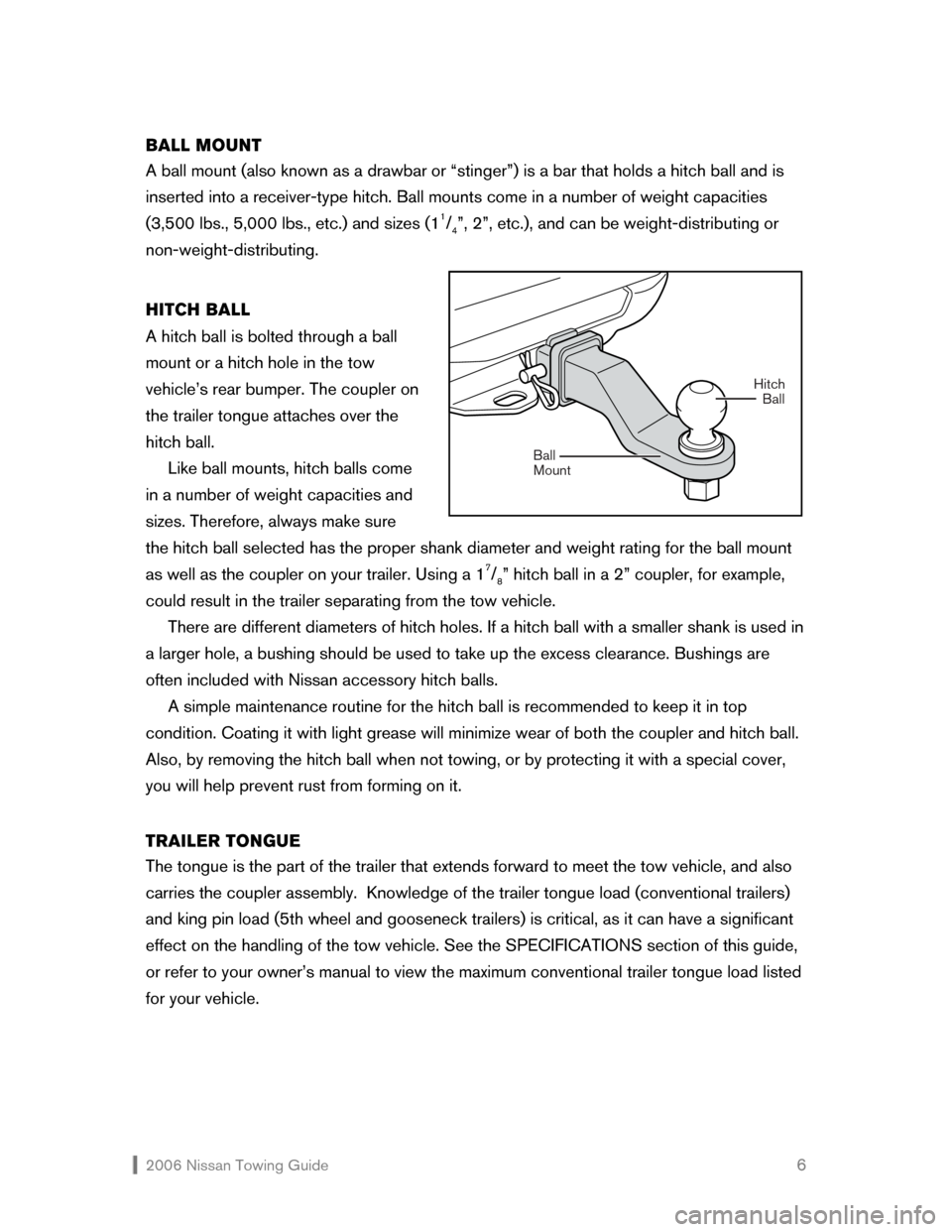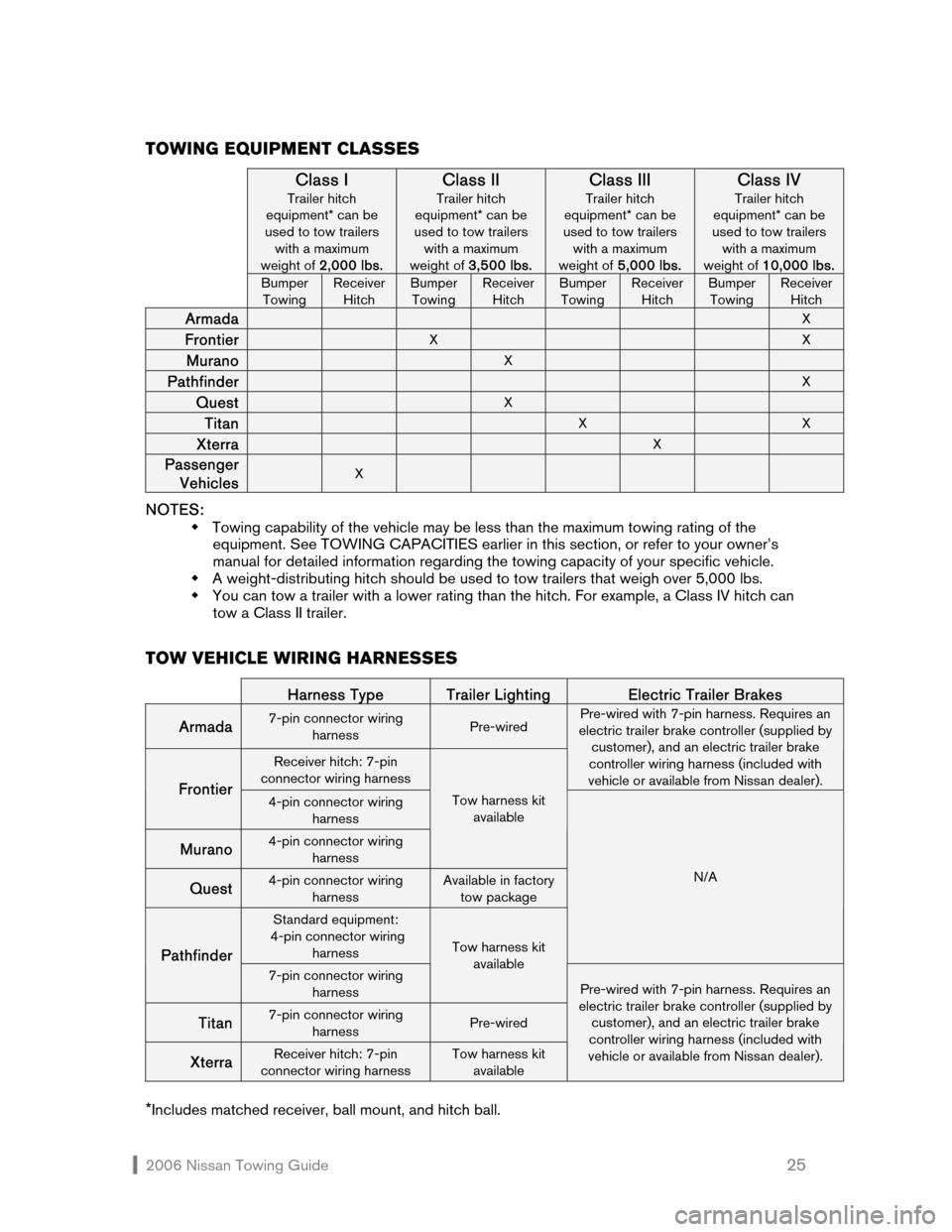2006 NISSAN XTERRA light
[x] Cancel search: lightPage 3 of 28

2006 Nissan Towing Guide 2
TOWING
EQUIPMENT
RENTING
The first thing to keep in mind when renting a trailer is to rent only from professional
companies that specialize in towing and towing equipment. More than likely, these
representatives will have some experience in selecting and fitting the towing equipment
that is appropriate for your Nissan vehicle.
When renting, make sure you have your owner’s manual on hand so that you can check
the towing capacities for your specific vehicle. Never rent a trailer that exceeds these
capacities, and make sure that any other equipment you rent is sufficient for your loaded
trailer.
While you’re there, ask questions: How much does the trailer weigh? What is the trailer
tongue load? How much weight will the trailer hold? What type of brakes is it equipped
with? All of these items have an effect on whether your Nissan vehicle is capable of safely
pulling that trailer or piece of equipment.
Make certain that all trailer stoplights, taillights, and turn signals are hooked up and
operate correctly, and that all safety equipment is properly installed. Check the safety
chains/cables, tie-downs, etc.
Carefully inspect the condition of the trailer and equipment. Are the tires worn
excessively? Are the tire pressures correct? Are there broken welds, missing bolts or
pieces? All these factors can also affect your safety.
Towing safety should be a high priority when choosing and renting equipment, and this
is especially true concerning hitches. Never rent a clamp-on-type hitch. Since Nissan
bumpers not specifically marked for towing are not designed for trailer loads, using this
type of hitch may cause damage to your vehicle and could result in trailer separation during
towing. Tow only with a permanent-type hitch.
PURCHASING
Purchase towing items such as hitches and hitch balls only from your Nissan dealer or a
professional supplier of towing equipment.
If you are intending to use your vehicle to tow a trailer you already own, first determine
the trailer’s weight when fully loaded. This will tell you if, in fact, your vehicle is capable of
pulling this amount of weight. In addition, it will also help you purchase the right type, style,
and class* of hitch and other equipment.
*See the SPECIFICATIONS section of this guide for equipment class information specific to your
vehicle.
Page 4 of 28

2006 Nissan Towing Guide 3 If you are buying a travel or boat trailer, be sure that your Nissan vehicle has the towing
capacity to pull it. See the SPECIFICATIONS section of this guide, or refer to your owner’s
manual for detailed information regarding the towing capacity of your specific vehicle. Your
owner’s manual should ALWAYS be referenced before making any towing decisions.
Naturally, you’ll want to buy the highest-quality equipment you can find for maximum
towing safety. And if you plan to tow often, consider convenience. Quick-disconnect trailer
light connectors and ratchet-type tie-downs, for example, make the job go faster and easier,
and are usually worth the small extra investment.
WHAT’S
RIGHT FOR YOU
TYPES OF EQUIPMENT
Towing requires a variety of equipment, and, depending upon the application, there can be
several types or styles of each piece of equipment. Working with your Nissan dealer or a
professional supplier of towing equipment, it should be relatively simple to determine the
proper type of equipment for your specific vehicle given the intended application. This
section explains the most common pieces of towing equipment available.
HITCHES
Whichever type of hitch you use, it should be firmly bolted to your vehicle, and should be of
the appropriate weight class for the equipment you intend to tow. In addition, keep the
following in mind:
�Š Do not modify the vehicle’s braking or exhaust systems or its body structure/frame when
installing the hitch.
�Š Be sure that the hitch does not interfere in any way with the vehicle’s energy-absorbing
bumper.
�Š Regularly check to see that all hitch-mounting bolts are securely fastened.
�Š Where practical, remove the hitch when not in use. Your Nissan dealer can assist you in
hitch removal and reinstallation. When removed, seal the bolt holes to prevent road
spray, fumes, water, and dirt from entering the vehicle.
�Š For receiver-type hitches using a ball mount, the ball mount should be removed when
not towing.
�Š If you install a hitch yourself, remember that it must be securely attached to the frame or
underbody, according to the manufacturer’s instructions. Never attach a hitch or
towing device to the vehicle axle housing. This may damage the housing, wheel
bearings, wheels, or tires.
Page 7 of 28

2006 Nissan Towing Guide 6 BALL MOUNT
A ball mount (also known as a drawbar or “stinger”) is a bar that holds a hitch ball and is
inserted into a receiver-type hitch. Ball mounts come in a number of weight capacities
(3,500 lbs., 5,000 lbs., etc.) and sizes (1
1/4”, 2”, etc.), and can be weight-distributing or
non-weight-distributing.
HITCH BALL
A hitch ball is bolted through a ball
mount or a hitch hole in the tow
vehicle’s rear bumper. The coupler on
the trailer tongue attaches over the
hitch ball.
Like ball mounts, hitch balls come
in a number of weight capacities and
sizes. Therefore, always make sure
the hitch ball selected has the proper shank diameter and weight rating for the ball mount
as well as the coupler on your trailer. Using a 1
7/8” hitch ball in a 2” coupler, for example,
could result in the trailer separating from the tow vehicle.
There are different diameters of hitch holes. If a hitch ball with a smaller shank is used in
a larger hole, a bushing should be used to take up the excess clearance. Bushings are
often included with Nissan accessory hitch balls.
A simple maintenance routine for the hitch ball is recommended to keep it in top
condition. Coating it with light grease will minimize wear of both the coupler and hitch ball.
Also, by removing the hitch ball when not towing, or by protecting it with a special cover,
you will help prevent rust from forming on it.
TRAILER TONGUE
The tongue is the part of the trailer that extends forward to meet the tow vehicle, and also
carries the coupler assembly. Knowledge of the trailer tongue load (conventional trailers)
and king pin load (5th wheel and gooseneck trailers) is critical, as it can have a significant
effect on the handling of the tow vehicle. See the SPECIFICATIONS section of this guide,
or refer to your owner’s manual to view the maximum conventional trailer tongue load listed
for your vehicle.
Hitch
Mount BallBall
Page 9 of 28

2006 Nissan Towing Guide 8 BREAKAWAY SWITCH
On a trailer with electric brakes, a breakaway switch can automatically activate the trailer
brake system if the trailer becomes separated from the tow vehicle. Should the trailer
become detached, a breakaway switch may help prevent the trailer from wandering into
another lane and will bring it to a safer stop with less damage.
A breakaway switch relies on the power of a trailer battery, so make sure it is not
discharged. Never use the breakaway switch to “park” the trailer on a grade. The battery
would eventually discharge and release the brake, allowing the trailer to roll.
Be sure to leave enough slack in the tether on the breakaway switch to turn corners
without binding. If not, the electric trailer brakes will lock-up and not release.
See your trailer manufacturer for proper installation of a breakaway switch that is
compatible with your trailer braking system.
TRAILER LIGHTS
Trailer lights should comply with all applicable federal, state, and local regulations, and
should be in proper working order at all times. A trailer’s taillights, stoplights, and turn
signals must be wired* into the tow vehicle’s electrical system. Many trailers use the same
filament of a dual-filament bulb for both stoplights and turn signals. The second filament is
used for the trailer’s taillights. All Nissan vehicles utilize separate filaments for each
function. Direct splicing of this type of trailer lighting may cause damage to your vehicle’s
electrical system and malfunction of the trailer lighting. When connecting your Nissan
vehicle to this type of trailer lighting system, a 3-wire to 2-wire power converter** must be
used. A power converter of this type creates only minimal additional demand (draw) on the
vehicle lighting circuits to power the trailer lighting.
Always check for correct operation of the turn signals, stoplights, and taillights every
time you connect a trailer for towing. Never replace vehicle fuses with fuses of a higher
amperage rating than the original.
NOTE – Improper or poor quality trailer harness wiring may affect your vehicle’s electrical
system. Use only a Nissan approved wiring harness, or consult your dealer or a
professional supplier of towing equipment for compatible equipment.
*See the SPECIFICATIONS section of this guide for wiring harness information specific to your
vehicle.
**Armada, Frontier, Pathfinder, Titan, and Xterra vehicles are pre-wired for trailer lighting and do not
require a converter.
Page 17 of 28

2006 Nissan Towing Guide 16 VEHICLE SPEED
Some states have specific regulations and speed limits for vehicles that are towing trailers.
Always obey these ordinances. Remember to reduce your speed in unsafe or less-than-
ideal road conditions or weather. When towing a trailer, braking distances increase while
handling agility decreases. Always leave yourself an extra margin of distance to respond to
emergency situations.
PASSENGERS
Never allow passengers to ride inside a trailer while it is being towed. Not only is this
unlawful in most areas, passengers could be seriously injured during sudden trailer
movement or in an accident. In addition, trailers may allow fumes from the tow vehicle to
leak inside. This could result in carbon monoxide poisoning from the engine exhaust.
VEHICLE MODIFICATIONS
Vehicle modifications — beyond those required for proper hitch installation, wiring hook-up,
and necessary cooling system upgrading — are not recommended for any Nissan vehicle
being used for towing purposes. Changes to the drivetrain, suspension, exhaust systems,
frame structure/unibody, or other vehicle components are not necessary for towing within
the limits described in this guide. These changes may diminish the reliability and longevity
of your vehicle and possibly void warranty coverage as well.
TOOL KIT
It is always a good idea to travel with a special tool kit when towing. In addition to tools, it
should contain flares, a flashlight, emergency reflectors, jumper cables, extra fuses, extra
radiator coolant, oil, and easily replaced spare parts such as taillight bulbs. You should also
carry spare tires for your tow vehicle and trailer, as well as a jack suitable for use on the
trailer. Be aware that not all automotive jacks can be used safely on a trailer.
BEFORE STARTING OUT
Before starting out on a trip, make one last inspection of the tow vehicle and the trailer. Are
the tire pressures correct? Are the safety chains/cables securely in place? Is the cargo tied
down securely? Do all the lights work? Is the coupler properly attached over the hitch ball
and secured using a locking pin? Is the breakaway switch hooked up and functioning
properly? Are vehicle and electric trailer brakes working properly?
Make a checklist of key items to be inspected, and don’t forget the basics. When
towing, vehicle engine oil, transmission oil, and coolant should always be checked before
starting out. Finding a potential problem while in your driveway is better than discovering it
miles from home.
Page 26 of 28

2006 Nissan Towing Guide 25 TOWING EQUIPMENT CLASSES
Class I
Trailer hitch
equipment* can be
used to tow trailers
with a maximum
weight of 2,000 lbs.
Class II
Trailer hitch
equipment* can be
used to tow trailers
with a maximum
weight of 3,500 lbs.
Class III
Trailer hitch
equipment* can be
used to tow trailers
with a maximum
weight of 5,000 lbs.
Class IV
Trailer hitch
equipment* can be
used to tow trailers
with a maximum
weight of 10,000 lbs.
Bumper
Towing
Receiver
Hitch
Bumper
Towing
Receiver
Hitch
Bumper
Towing
Receiver
Hitch
Bumper
Towing
Receiver
Hitch
Armada X
Frontier X X
Murano X
Pathfinder X
Quest X
Titan X X
Xterra X
Passenger
Vehicles X
NOTES:
�Š Towing capability of the vehicle may be less than the maximum towing rating of the
equipment. See TOWING CAPACITIES earlier in this section, or refer to your owner’s
manual for detailed information regarding the towing capacity of your specific vehicle.
�Š A weight-distributing hitch should be used to tow trailers that weigh over 5,000 lbs.
�Š You can tow a trailer with a lower rating than the hitch. For example, a Class IV hitch can
tow a Class II trailer.
TOW VEHICLE WIRING HARNESSES
*Includes matched receiver, ball mount, and hitch ball.
Harness Type Trailer Lighting Electric Trailer Brakes
Armada 7-pin connector wiring
harness Pre-wired
Receiver hitch: 7-pin
connector wiring harness
Pre-wired with 7-pin harness. Requires an
electric trailer brake controller (supplied by
customer), and an electric trailer brake
controller wiring harness (included with
vehicle or available from Nissan dealer). Frontier 4-pin connector wiring
harness
Murano 4-pin connector wiring
harness
Tow harness kit
available
Quest 4-pin connector wiring
harness
Available in factory
tow package
Standard equipment:
4-pin connector wiring
harness
N/A
Pathfinder
7-pin connector wiring
harness
Tow harness kit
available
Titan 7-pin connector wiring
harness Pre-wired
Xterra
Receiver hitch: 7-pin
connector wiring harness
Tow harness kit
available
Pre-wired with 7-pin harness. Requires an
electric trailer brake controller (supplied by
customer), and an electric trailer brake
controller wiring harness (included with
vehicle or available from Nissan dealer).